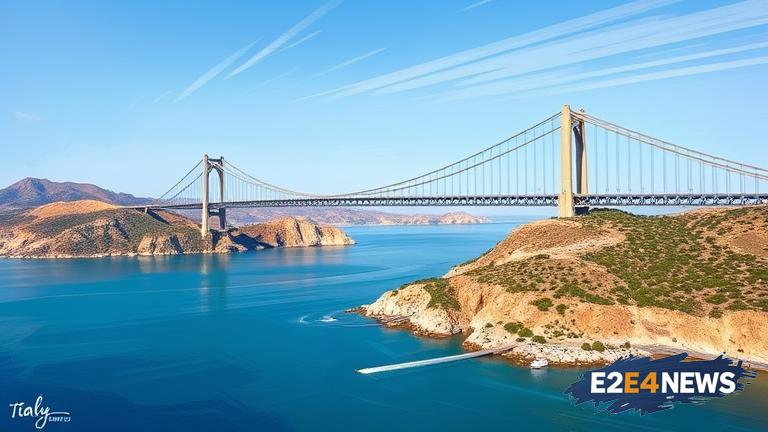The Sicily Bridge project, a proposed bridge connecting Sicily to the Italian mainland, has been at the center of controversy in recent weeks. The project’s builder has assured that the bridge is not intended for military use, despite concerns raised by some that it could be used to facilitate the movement of military equipment and personnel. The Italian government has been keen to emphasize the bridge’s potential to boost economic growth and improve connectivity between the island and the rest of the country. However, critics argue that the project’s true intentions are more sinister, and that it could be used to further Italy’s military interests in the region. The debate over the Sicily Bridge has sparked a wider discussion about Italy’s defense spending and its priorities in terms of infrastructure development. Some have argued that the country’s military budget is already too high, and that funds would be better spent on projects that benefit the general population, such as education and healthcare. Others have countered that a strong military is essential for national security, and that the Sicily Bridge project is a necessary investment in the country’s defense capabilities. The project’s builder has sought to reassure critics that the bridge will be used solely for civilian purposes, such as facilitating the movement of goods and people between Sicily and the mainland. However, the fact that the project is being funded in part by the Italian military has raised eyebrows, and some have questioned whether the bridge’s true purpose is being concealed. The Sicily Bridge project has also sparked concerns about the potential environmental impact of the project, with some arguing that it could damage the marine ecosystem and disrupt the natural habitats of local wildlife. Despite these concerns, the Italian government has pressed ahead with the project, arguing that it is essential for the country’s economic growth and development. The project has been estimated to cost billions of euros, and is expected to take several years to complete. The Italian government has said that it will work to minimize the project’s environmental impact, and has pledged to implement measures to protect local wildlife and ecosystems. However, critics remain skeptical, and have called for greater transparency and accountability in the project’s planning and implementation. The debate over the Sicily Bridge project has highlighted the complex and often competing priorities of infrastructure development, national security, and environmental protection. As the project moves forward, it is likely that these tensions will continue to play out, with different stakeholders and interest groups vying for influence and advocating for their respective priorities. The Italian government will need to navigate these competing demands carefully, balancing the need for economic growth and development with the need to protect the environment and ensure national security. The Sicily Bridge project is just one example of the challenges that governments face in balancing these competing priorities, and it will be interesting to see how the project unfolds in the coming years. The project’s outcome will have significant implications not just for Italy, but for the wider region, and will likely be closely watched by other countries and international organizations. The European Union, in particular, will be keen to see how the project is implemented, and whether it complies with EU regulations and standards. The project’s success or failure will also have implications for the future of infrastructure development in the region, and will likely influence the planning and implementation of similar projects in the years to come. The Sicily Bridge project is a complex and multifaceted issue, and one that will require careful consideration and planning to ensure its successful implementation. The Italian government must work to address the concerns of critics, while also ensuring that the project is completed on time and within budget. The project’s outcome will have significant implications for the future of Italy and the wider region, and it is essential that it is implemented in a responsible and sustainable manner.
